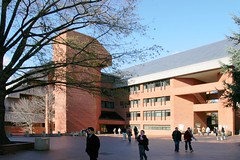In 1874, the president of Georgetown began a campaign to enlarge the physical facilities of the College. By 1876, a design for what-we-now-call Healy Hall was drafted. In late 1877, construction began. From the start, raising money for the initiative plagued the president, as the enormous sum of $200,000 to construct the building was far beyond the funds available. Indeed, a loan was needed to finish the last part of the exterior of the building, in late 1879. Usable interior space was not completed until 1881, some 4 years after construction began. Even then, the library and the auditorium were not completed for another decade. So, from 1877 to 1881, the campus was in a construction phase.
In 2024, of course, it is difficult to imagine Georgetown University without the visual image of Healy Hall. The investment in the structure is a great example of trials and tribulations of one time yielding a much better future. Institutional citizenship is like that. One generation makes sacrifices to create a better future for the next generation.
Over the coming two years, all of us working at Georgetown’s Hilltop Campus will experience our own disruption with an aim of a better future. While no one can claim that the legacy of this disruption will be as glorious an iconic transformation of the university as Healy Hall, it supplies infrastructure equally important as a new building.
Under the Hilltop Campus, below bricks, asphalt, and grass, lies over a mile of pipes. The pipes carry steam to heat central buildings as well as university buildings around 36th and Prospect. Some of the pipes are nearly 100 years old. They lie in tunnels, of a similar age, some of which are experiencing a slow collapsing. Hence, there are repeated failures of heating system delivery and continuous undesirable leakage of energy in the delivery process. Patching them over and over again has reached an end point. We can’t go on like this.
At the same time, the institution has committed to a set of sustainability targets. It has entered into a partnership with a global firm of energy professionals to attain those goals. Fixing extensive leakage of energy in our systems is low-hanging fruit to achieve those goals.
Ironically, waiting a 100 years to replace such infrastructure does have a silver lining. Today’s energy technologies offer radically more efficient systems of delivering heat to university buildings than was true 100 years ago. So, we are joining other institutions that have moved from steam heating to hot water heating. Why? It appears there is less heat loss during transmission with hot water than with steam. It uses lower pressures, requires less maintenance, and fits more easily into modern HVAC systems. In short, it promises higher efficiencies on our way to reducing our carbon footprint.
The burden of this innovation is that there will be significant digging around the campus over a two year period. So, we all need to get accustomed to construction fencing in the front portion of the Hilltop campus inside the gates and later, outside the gates to Walsh and LXR.
It will be done in phases, with two important commitments: first, legacy trees will be protected as much as possible; second, commencements and outdoor gatherings on Healy and Copley lawns will not be disrupted. Work will be scheduled to permit our ritual outdoor events, so important to students and their families.
In addition to improved energy efficiency, the project offers another benefit – after the underground work is complete, we’ll see a redesigned front of the campus, with improved stormwater management (goodbye to Copley Lake and its two ducks), consistent attractive walkways, improved campus lighting, and a more integrated landscape architecture, with native plantings that might have been there in the 1780’s.
Thinking back to the Georgetown’s early days, I can imagine the faculty and staff of the 1880’s and 1890’s telling their grandchildren, as part of a campus tour some years later, that they were on campus when Healy Hall was first opened. They would describe the noise and naked infrastructure arising, how workers were onsite for months and months through their own academic activities. But I imagine they would tell the listeners these stories with a bit of pride in their part in seeing the college grow into a more impactful institution.
Now, I don’t imagine that we will tell such vivid stories about this moment some twenty years from now. Unseen pipes buried underground do not generate the emotional memories that a new prominent edifice can generate. However, we can tell our grandchildren that we were here when the university made good on major commitments to sustainability by making long-term investments to achieve that state. And, we were proud to put up with the temporary mess as those investments were made — our generation’s little contribution to a better Georgetown future.
Address

ICC 650
Box 571014
37th & O St, N.W.
Washington, D.C. 20057
Contact
Phone: (202) 687.6400
Email: provost@georgetown.edu
Office of the ProvostBox 571014 650 ICC37th and O Streets, N.W., Washington D.C. 20057Phone: (202) 687.6400Fax: (202) 687.5103provost@georgetown.edu
Connect with us via:
Great reminder of our roots and the pains endured to plant those roots. If we don’t change and grow we are in danger of our roots withering . Thanks.